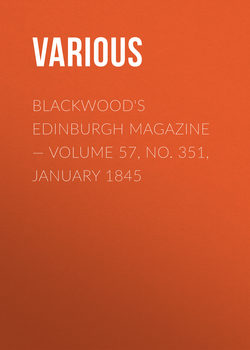Читать книгу Blackwood's Edinburgh Magazine — Volume 57, No. 351, January 1845 - Various - Страница 6
A RAMBLE IN MONTENEGRO
ОглавлениеFew nations of Europe have been less known than the Montenegrians, and the name even of their country is seldom found on maps.6 Surrounded by great empires, they have always preserved the independence of their rugged mountains, and have even succeeded in wresting several rich plains from the sway of Turkey. With this power hostilities seldom cease; but such is the system with which her resources are managed, that while the Montenegrians are at peace with one pasha, they are enabled to concentrate their force against another — and all the while the Sublime Porte does not condescend to interfere. Not many years ago, they possessed the reputation of being a horde of robbers; and, in all probability, the pilgrim who ventured among them would have returned, if at all, as shirtless as themselves. But the breath of the spirit of the age, though faintly wafted to their mountains, has softened something of their character, without destroying in the least their independence or nationality. Bold, hardy, and free, ready and eager for the foray and the fray, a stranger is now as safe among them as in any part of her Majesty's kingdom.
Whoever wishes to make the acquaintance of this primitive people, will do well to embark on board the Austrian Lloyd's Company's steamer from Trieste to Cattaro. They will be well accommodated, at reasonable charges, and have an opportunity of seeing the principal towns of Dalmatia, a country little frequented by travellers. Such was the case with ourselves, (an English lady and gentleman,) who quitted Trieste on the 5th of November 1843. The voyage commenced pleasantly, and we had the good-luck to have the ladies' cabin to ourselves. The captain was a very gentlemanlike person, the steward attentive, and the passengers full of politeness. Zara, the capital of Dalmatia, where we stopped a day and a night, is a walled town of moderate extent, said to contain 8000 inhabitants. It possesses some antiquities. Over the gates of this, and all other of the Dalmatian seaports, the Lions of Saint Mark yet remain. It is best known for the excellence of its rosoglio. The next town we arrived at was Sebenico, now much decayed, and Spalatro, the most interesting of all, where the badness of the weather, during the short time we stayed, prevented our landing to see the extensive Roman remains. After anchoring off Curzola for a night, we came to Ragusa, where we stopped two days. At Zara and Sebenico we had opportunities of seeing the Morlaccian race. These are the rural inhabitants of Dalmatia, speaking a Sclavonic dialect, while in the towns they pride themselves on their Venetian origin and language. Amongst these peasants were the noblest specimens of the human kind I have ever seen. Of stature almost gigantic, and of the amplest development of chest, their symmetry of limb and elasticity of step would have called forth notice in a Scottish Highlander. Nor could a somewhat manifest omission to cares of the toilet disguise complexion and features almost faultless, and in which an expression of frankness and good-nature left one nothing to fear from their armed numbers. I speak not of a few among a crowd, but of nearly all I saw. It was from amongst these that the French, during their occupation, chose their finest grenadiers; but at present, in consequence of the scantiness of the population, the humanity of the Austrian government has suspended all conscription. Still it is possible, that, in the hour of danger, Austria might profit more from the devoted loyalty of this armed and stalwart peasantry, than if her ranks were filled with its forced recruits. Their dress consists of a coarse brown jacket, and a waistcoat of red cloth, both ornamented on the edges, and made to sit close on the shoulders, without any collar, and which advantageously display their well put on head and neck. They wear a small red skull-cap, round at top; but, when married, they usually surround this with a white turban. Their pantaloons are of blue, and fit close from the knee to the ankle, and below they wear the opunka
6
An excellent map of Montenegro has been made by an Austrian officer of engineers, who resided there for the purpose — but I have not now the advantage of referring to it. This country is divided into twelve military departments; the natives reckon its extent about three days' journey in the longest, by two in the widest part. Those, of course, are foot or mule journeys.
